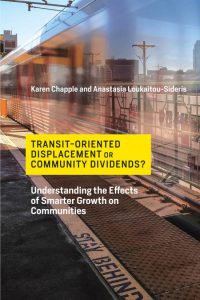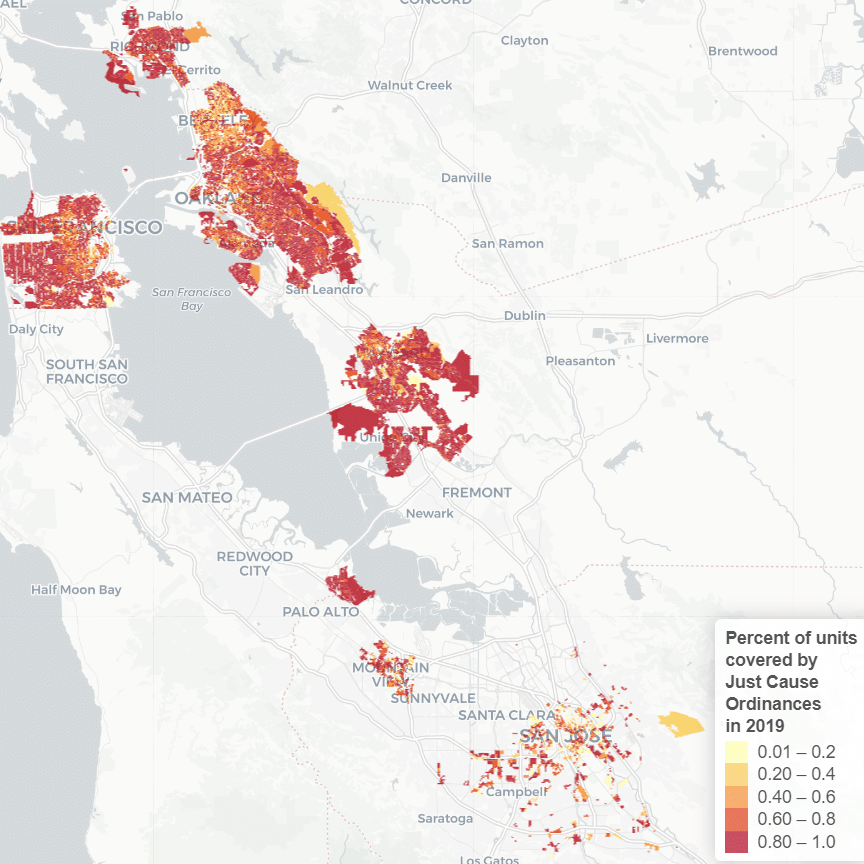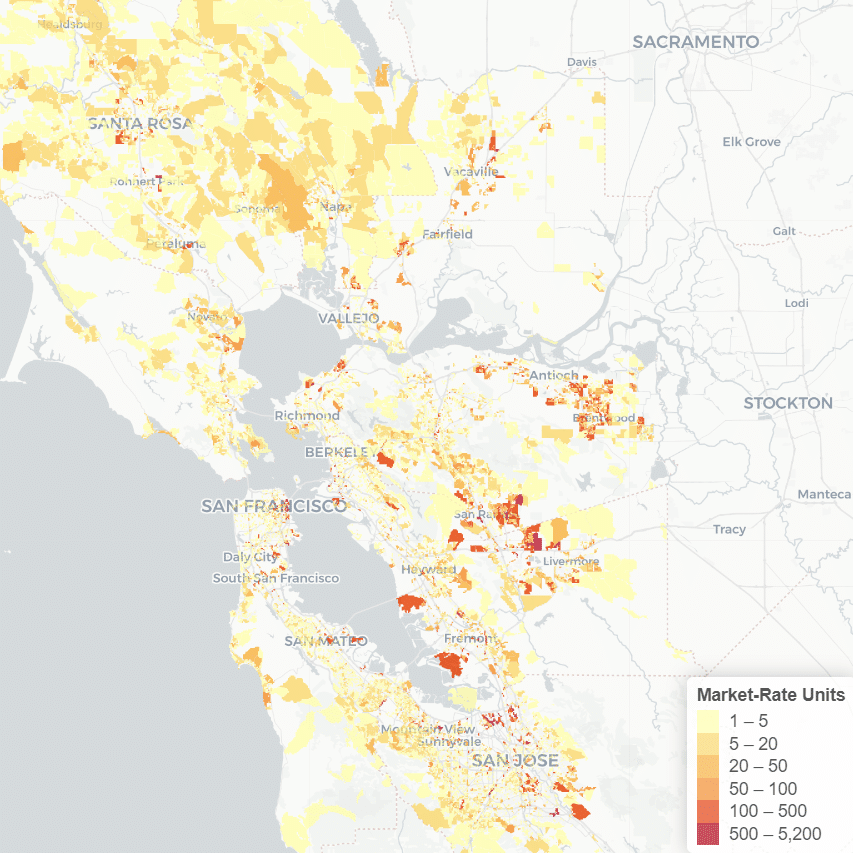Many cities struggle with the question of how to invest in ways that help curb greenhouse gas emissions without displacing residents. The stakes are high: displacement has lasting impacts on physical and psychological well-being, community cohesion, and long-term economic mobility. Moreover, when low-income people of color are displaced from communities by rising housing prices, patterns of re-segregation emerge, perpetuating racial inequity.
Anti-displacement policies and toolkits abound, but cities are realizing that solving this intractable problem is not going to be simple. At the Urban Displacement Project, we’ve been studying gentrification and displacement patterns in California and around the country for six years. Currently, we are working with SPARCC to replicate our gentrification and displacement typology maps in SPARCC sites, and work toward building a cross-context national narrative of gentrification and displacement. In “Safeguarding Against Displacement: Stabilizing Transit Neighborhoods,” a chapter in Transit-Oriented Displacement or Community Dividends? Understanding the Effects of Smarter Growth on Communities, Miriam Zuk, Anastasia Loukaitou-Sideris, and Karen Chapple detail some hard-won lessons on anti-displacement strategies.

Researchers still have many unanswered questions about how investments drive displacement. However, cities should not avoid investing in their communities in order to avoid displacement. Instead, they should adopt anti-displacement policies and frameworks as they invest. The question should not be whether to invest, but rather, how can investments be leveraged to ensure residents get to stay by choice and reap the benefits of new amenities, increased accessibility, and newly added resources?
To start, being proactive is critical—cities must center equitable development and anti-displacement as they plan for new investments. It is important to plan and adopt policies and programs before the investment is even announced instead of after, when prices have already risen and people have already been displaced. At the same time, cities must be responsive to ongoing gentrification and displacement pressures while they are working to avoid those forces in the future. And anti-displacement policy strategies must take into account the varied drivers of displacement—changing regional housing trends, exclusionary markets, poverty, income inequality, and disinvestment can all lead to displacement. A series of strategies that follow the widely used Three P’s anti-displacement framework could help: tenant protections, production of affordable housing, and preservation of affordable housing. (A more comprehensive list of anti-displacement policy strategies can be found here.)
Protections
Tenants need protection from ever-rising rents, eviction pressures, and myriad other displacement pressures. Two proactive strategies are rent stabilization, which protects tenants from rent hikes, and requiring landlords to have a just cause to evict, which protects tenants from arbitrary evictions. These two strategies need to go hand in hand to be effective. Due to the ever-deepening housing affordability crisis, campaigns have emerged around the country to expand rent regulation, including efforts to reform or repeal state restrictions in Washington, Oregon, California, and Colorado. Debate continues amongst academics, tenant advocates, the real estate industry, and policymakers about the pros and cons of rent regulations including their potential effects on housing production and quality, but the impact on sitting tenants is clear: turnover and economic displacement are reduced for residents of rent-regulated units.
Responsive strategies are also key. One increasingly popular effort is guaranteeing a tenant’s right to counsel in evictions cases—cases tenants would likely lose without proper representation, something many low-income tenants are unlikely to be able to afford. New York City and San Francisco are both experimenting with such programs and a number of other cities, including Philadelphia, are considering them. In Chicago, the Lawyers’ Committee for Better Housing found that having a lawyer decreases a tenant’s odds of getting evicted by about 25 percent. Assessments of the first two years of the program in New York City find that while eviction rates have decreased, thousands of people are still being evicted. More research is needed to understand how responsive strategies can most effectively keep people in their homes.
Production
To prevent future displacement, among the most effective strategies is the production of permanently affordable housing. Our research finds that subsidized housing is twice as effective as market-rate housing in mitigating displacement. Proactively, acquiring land for affordable housing production before a major investment is announced is a smart strategy to promote neighborhood affordability. For example, in a unique case, TriMet, a transit agency in Portland, acquired and banked land adjacent to a light rail expansion, and later dedicated it to subsidized affordable housing development, using transit money and federal funds.
In many U.S. cities, new housing is needed to address the supply and demand mismatch. To this end, policymakers around the country are looking to reform both zoning and permitting processes to help ramp up production. In our brief on California’s upzoning bill (SB 50) we highlight core equitable development considerations for any strategy that seeks to step up the pace of construction. For example, increases in land value should be captured for public benefit through inclusionary zoning, housing trust funds for affordable housing production and preservation of existing affordable housing, and funds towards tenant protection programs. One way to do this is to open up high-opportunity neighborhoods to low-income households. At the same time, policymakers should make efforts, through state and local policy, to stabilize neighborhoods as new developments take root.
In terms of responsive policy, when affordable housing is produced, cities often consider preference or right to return policies. These policies offer housing opportunities to those who have already been displaced so they can return to their communities. Such policies are in place in a number of cities, including Santa Monica, Cambridge, San Francisco, and others. Portland’s North/Northeast Preference Policy is an innovative example that seeks to recognize and address historic injustices of displacement through urban renewal in historically Black North/Northeast Portland. Through this policy, residents receive preference in affordable units in the area if they, their parents, or grandparents have a current or former address in that zone, as well as if a member of the family experienced the seizure of their property through urban renewal.
Preservation
Preservation of existing affordable housing stock can help keep neighborhoods more affordable. Preserving existing units is often more cost-effective than building new affordable housing, and can be a good approach in places that are already built out. Funds for acquisition and rehabilitation can be leveraged in the lead-up to an investment to remove land from the speculative market, establish long-term affordability, and help stabilize neighborhoods. For example, in anticipation of rising housing costs in the Globeville and Elyria-Swansea neighborhoods of Denver, a neighborhood coalition started a community land trust, leveraging funds from the Colorado Department of Transportation. Community land trusts acquire land and maintain ownership permanently, with prospective homeowners entering into long-term renewable leases of the land and getting the chance to build some wealth and equity. Research points to community land trusts as a potential tool in equitable transit-oriented developments, and public agencies can play a critical role in facilitating land acquisition and funding.
Preservation can also be done responsively, where the threat of displacement triggers strategic acquisition/rehabilitation for long-term affordability. For example, in San Francisco’s Small Sites program, lower-income tenants in small buildings can nominate their building for acquisition/rehabilitation by nonprofits. The program actively seeks to support residents facing displacement pressure; as of 2016, 30 percent of the people whose units were acquired and stabilized were under active eviction proceedings, which were stopped through this program. In Washington, D.C., the Tenant Opportunity to Purchase Act gives right of first refusal to tenants who are threatened with displacement because their building is up for sale. Tenants can either purchase or assign purchase rights to a nonprofit, enabling them to form cooperatives and condo associations that provide ongoing ownership. Since 2015, over 1,400 units have been preserved through the Tenant Opportunity to Purchase Act.
Guiding Principles
Considering a menu of policies across the Three P’s, including both proactive and responsive strategies, we’ve compiled a list of guiding principles that can help cities and advocates prioritize solutions best suited to their context:
- Understand your community: Data and analysis are critical to understanding what is happening in communities and ensuring that strategies are tailored to their needs. What stage of change are neighborhoods in? What is the condition of the housing stock? What kinds of pressures are residents facing? Analyzing available data, and collecting information by talking to residents, real estate agents, developers, and community groups, is the first step in understanding what’s needed and helping to find a balance between proactive and responsive strategies.
- Engage the community in the design and implementation of solutions: Early warning systems are helpful but should not replace engaging community groups to better understand what residents’ most pressing challenges are and what support they need to be able to stay in their homes and communities. Partnerships are also critical for implementation. For example, in D.C., several community-based organizations are contracted by the city to do outreach around the Tenant Opportunity to Purchase Program. These organizations make sure tenants are aware of, and can access, their right to acquire or allow a nonprofit to acquire their building.
- Get ahead of investments and change: Property appreciation and speculation happen rapidly after investments have been announced; once that market signaling has happened, it can feel like it’s already too late to stem the tide of displacement pressures. It is therefore imperative to implement policies and carefully consider how to minimize displacement impacts long before investments are made public.
- Consider scale: How does the scale of the solution you’ve identified compare to the scale of the issue? How many households would be helped by a suite of interventions versus how many households are at risk?
- Remember that implementation doesn’t happen on its own: With any policy, there is a difference between what’s on the books and what is enforced. It is essential to design and fund strong enforcement mechanisms in anti-displacement policies. For example, rent regulation programs should have the resources to establish rental registries and follow up on information they collect. This can make all the difference for a household on the verge of being priced out of a home.
- Organize: Community organizing is key in getting good-fit policies passed in the first place. Organizing can also ensure long-term accountability so that policies go beyond checking a box and actually lead to meaningful outcomes for residents.
- Remember how we got here: We must recognize history, and the realities and legacies of racist urban policy in order to address historical injustices. One example of this is the fight to identify “sensitive communities,” where implementation of California’s proposed SB 50 upzoning policy would be deferred during a community planning process. Advocates have insisted that communities that have been most burdened by discriminatory policies “deserve sufficient time and self-determination to plan for an inclusive future for their neighborhood.”
While anti-displacement work can feel like an uphill battle, there is hope. There has been a dramatic increase in recognition of the problems of gentrification and displacement over the past five years. This recognition is coupled with an increase in organizing and coalition-building work. The Three P’s are taking off; because there are no silver bullets for equitable development, policies must incorporate protections, preservation, and production. Decision makers and community leaders must come together to understand how these approaches can work in conjunction in a specific community. If the right people are involved—particularly those who are most likely to be affected—large campaigns, regardless of their overall success, can establish the foundation for a community’s future organizing and planning efforts.
We believe everyone has a right to live in a place where they are safe, feel a sense of belonging, and where they have access to good schools, healthy food, public transit, nearby employment opportunities, and green space—the building blocks of a healthy, fulfilling life. When communities are at the table in planning processes, armed with accessible data and knowledge about effective policy strategies, they can help ensure that investments are leveraged to create more inclusive futures.
This blog is cross-posted at Shelterforce, Nonprofit Quarterly, and SPARCC Hub.






